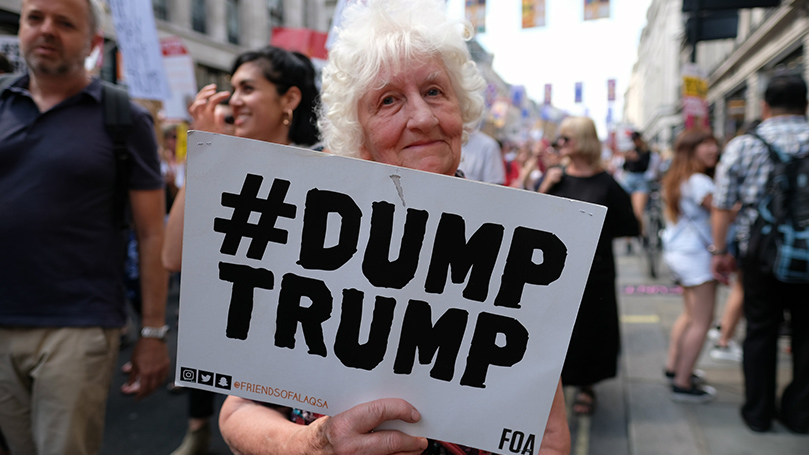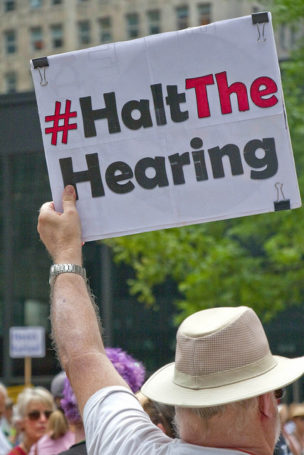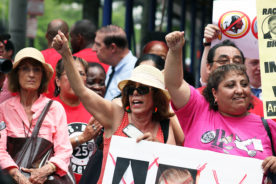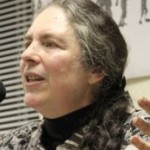
There are just a few weeks before the November 6 election; just a few weeks to put the breaks on the fascist project led by Trump and open the door for an offensive for people’s needs. What we do every day counts.
Labor Day parades and other actions in many communities across the country set the stage.

The Kavanaugh Supreme Court hearings epitomized the fierce battle underway to preserve basic democratic structures and hard won rights including the right of workers to a union, of women to choice, of immigrants to due process, of African Americans to the very right to vote.
The Republican majority shut down normal procedure at the hearing in order to jam the nominee through on behalf of corporate interests and the Trump administration. The resistance in response included Judiciary Committee Democrats who called for the hearing to adjourn, Women’s March activists who courageously disrupted from the gallery, and millions of people including union members, civil rights activists and environmentalists across the country flooding the phone lines of their U.S. Senators.
It’s a long shot to prevent this travesty of justice, but the fight forward reflects a wide range of communities and interests brought together to stave off fascism’s knock at the door.
Revelations about the scary state of affairs in the Trump White House contained in Bob Woodward’s book, the New York Times Op-Ed by an anonymous senior staffer, along with the Mueller investigation are shaking things up. But what happens will depend on a giant blue wave in these elections.
The November 8 elections are the front line of the class struggle.
The November 8 elections are the front line of the class struggle. These elections are a matter of life and death for the working class and for our planet itself.
We should reaffirm our strategy and tactics including our priorities:
- Build broad based unity to flip Republican seats so they do not continue in the majority;
- Elect candidates who come out of labor, communities of color and other movements ready to fight for the people and;
- Build the base for the Communist Party as well as labor, women and other movements for the long term.
Despite big corporate money being invested in state after state, and extraordinary voter suppression methods to maintain Republican control, it is possible to flip the House and even the Senate and many governor’s seats and state houses this November. Polls are now conceding that possibility.
Long held Republican strongholds are shifting in response to basic economic needs. That was shown in the special elections in Alabama, Pennsylvania and Ohio with candidates who focused on rising economic insecurity.
Also showing shifts is the overwhelming vote and big victory in Missouri that overturned their state legislature’s right-to-work law — in a state that Trump carried. That says many who voted for Trump were brought into the right-to-work opposition movement. The campaign message reached far beyond union members and appealed to common economic needs and should be studied.
Also in Missouri: congratulations to Tony Pecinovsky who is running for Alder in St. Louis in 2019. And we can note that Michael Brown’s mother has announced she is running for Alder in Ferguson at that time.
Another example of class unity is the wave of teachers strikes and ongoing voter mobilization in the red states of Oklahoma, Kentucky, West Virginia and in particular Arizona. Outrageously, the Arizona court has ruled to deny ballot status for a tax the rich initiative to fund public education signed by 270,000 of voters. But the mobilization continues.
During the primaries, Trump weighed in on behalf of Republican candidates who embrace an anti-union, anti-immigrant, militaristic agenda and who are now their Party’s nominees.
In this context and with a green light from the White House, vicious hate crimes and white supremacist rallies are on the rise. In Des Moines, Iowa when graffiti saying “Deport Illegals” was scrawled across the roads at night, the community immediately came together and created billboards saying “One Des Moines Community No Hate.” These kind of responses help build unity and voter turnout.
On the Democratic side of the primaries, many historic firsts have been won. A record number of first time new candidates have stepped forward, many becoming their Party’s nominees, including dozens of union members and women of all races and nationalities and young people. Across the country it is the year of the woman. Even where these candidates did not win their primaries, their campaigns expanded the number of voters, inspired and brought new people into the process.
Common goals to flip Republican districts are a point of unity going forward.
As we know it hasn’t all been smooth. There has been resistance from established Democratic leaders. Some challengers had narrow tactics. But the common goals to flip Republican districts at this dangerous moment are a point of unity going forward that we should find the ways to foster.
Of note is the front-and-center role of labor: One example is in Connecticut where Jahana Hayes won the primary in the open CD 5. She is a real working-class fighter, was national teacher of the year, and if elected will be the first African American woman in Congress from this state. She says, “If Congress reflects us (working people), nothing can stop us.” In the primary the Connecticut AFL CIO, the teachers unions, the Working Families Party and many others bucked the endorsed Democrat to support Hayes.
There are many other union members running for Congress and I believe hundreds running across the country for state legislature. In Wisconsin, union iron worker Randy Bryce won in the primary for Paul Ryan’s open House seat. In Minnesota union candidate Tim Walz won the primary for governor.
A recent national phone conference call for AFL-CIO members was attended by over one million people.
1 million workers participated in a AFL-CIO conference call on the elections.
There are many other historic primary wins by women and people of color who have stepped forward as part of the anti-racist and working-class resistance. To mention a few:
The southern Governor races:
- Georgia: Stacey Abrams would be the nation’s first African American woman governor;
- Florida: Andrew Gillum would be his state’s first African American governor;
- Maryland: Ben Jealous would be his state’s first African American governor;
- Arizona: David Garcia would be his state’s first Mexican American governor in 44 years.
Midwest:
- Minnesota – Ilhan Omar (Keith Ellison’s open seat) would be the first Muslim woman in Congress from her state.
- Michigan – Rahida Tlaib (CD 13 Conyer’s former seat) would be the first Muslim woman in Congress from her state.
East coast:
- New York – Alexandria Ocasio Cortez would be a democratic socialist in Congress from her state;
- Massachusetts – Ayanna Pressley, the first African American on Boston’s City Council, would be the first African American member of Congress from her state;
- Vermont – Christine Hallquist would be the first transgender woman governor in her state.
Most of these historic candidates are running on issues that have majority support and meet the needs of working people including Medicare for All, paid family and medical leave, raising the minimum wage and immigration reform. They are helping to change the political climate and inspire voter participation.

With the primaries nearly over, the full force of the democratic movement is now geared to November 6 and mobilizing the broad united front.
In an op-ed in The Hill, Congresswoman Rosa DeLauro debunked the media frenzy about in-fighting in the Democratic Party. She says “They couldn’t be more wrong. Democrats are united on the issues facing our country right now — whether it’s alleviating the economic pressures on working families, fighting for health care, defending public education, or eliminating big money out of politics. We are not going to back down from our work to fix these problems, and we are not going to stop demanding a better future for working families.”
In the Political Action Commission and National Board we have reviewed the competitive races in states where we have Communist Party presence in order to determine how to most effectively deploy our resources with the interconnected goals of contributing to the election results and also strengthening our Party and People’s World at the local level. A plan for staff travel is being worked out with each district.
This includes the House and Senate, Governors, Attorneys General and State Legislators who can all serve as a firewall against the Trump administration’s assault on working people and democratic rights.
Congress:
In the House Democrats need to flip 24 Republican seats in addition to holding on to the 194 seats they have to be in the majority. We are involved in 38 Republican seats that can be flipped: AZ, CA – 7, CO, FL-2, IL-2, IA-2, MI, MN-2, NJ-3, NY-3, OH-2, PA-5, TX-3, VA-4, WA-2, WI.
In the Senate 24 Democrats and 9 Republicans are up for re-election, a total of 35 seats. Democrats need to win 28 of the 35 seats to gain a majority.
We are involved in two states where a Republican seat can be flipped: AZ (Flake open), TX (Cruz), and five states where a Democratic seat needs protection against being lost: FL (Nelson), IN (Donnelly), MO (McCaskill), NJ (Menendez)
Governors:
We are involved in 8 states that can flip Governors from Republican to Democrat: Four in the South AZ, FL, GA, MD and four in the Midwest: IL, IA, MI, OH There is interest in developing a common approach with labor in the Midwest to defeat these reactionary governors who support right-to-work.
We are also involved in two states in danger of flipping Governors from Democrat to Republican: CT, and MN (could be part of a Midwest approach)
Overall, we have identified five states where we are involved that have the largest number of toss ups from Congress to State House. These should be a special focus: AZ, FL, MI, MN, PA.
There are five states with our own or very close candidates for local offices: AZ, TX, MO, IL, CT.
There are three states with important races for Congress and State House that have smaller Party organization: GA, WI, NV.
These findings are guiding the plan for staff travel, being worked out with each local area. These visits are projected to center around building the Party and the People’s World in the context of the elections. For example, this might include:
- Discuss with our members why the elections are a key part of the class struggle and protecting that inch that we need to survive;
- Make a plan to share and circulate the People’s World stories that visiting staff write;
- Outreach to labor and other allies where that is helpful;
- Work with voter registration and get-out-the-vote efforts and challenging voter suppression measures that will be a decisive factor in this election;
- Work with new members and form new clubs where that is possible;
- Organize an event to invite people to that we work with in elections.
What is to be done?
In every club in every state, the local Party organization should think through how to fully mobilize members, family, friends, co-workers and neighbors. How can the Party participate with allies and find creative ways to move whole communities to vote en masse: neighborhoods, organizations, churches, schools, rallies and marches to the polls There are already examples including the new candidates who have stepped forward, the Parkland students national voter registration tour, the Labor 2018 campaign.
The People’s World has an important part to play with coverage of national issues that voters are concerned about and especially on-the-ground coverage of campaigning. The People’s World can put the elections in a framework that resonates with ordinary people. The use of those articles can make an good contribution to the Party and club building work we are doing.
One tool suggested is producing promo cards that encourage people to vote and to sign up to subscribe online to the Peoples World. Such a tool could help increase voter turnout and increase our subscription lists.
Building the Communist Party is inseparable from winning elections. Our analysis provides the context for understanding the need for unity in order to move forward Building the Party is an important part of our contribution to the elections.
The spiraling crisis of capitalism, the rise of hate and the war danger, is forcing many people, especially the young generations, to question the system that is not allowing them to have a decent future. They are looking for alternatives. Bernie Sanders message helped put democratic socialism in the mainstream of talk. There are DSA candidates in many states. This is great and shows the potential for building our Party as one that is committed to a socialist system instead of capitalism.
The power of having Communist Party organization is the ability to carry out a unified approach for the elections, and then keep it going after election day organizing on the issues of living wage jobs, health care, student debt, systemic racism and supremacy.
As has been said, with fascism knocking at the door, and with a new awakening and radicalization, the next 61 days is a huge challenge and a singular opportunity to move forward. Talk is not enough. We need concrete plans, follow through, and a unified commitment from now to Election Day. Then we can examine the results, hopefully they will be positive, and determine what comes next.
This report was presented to and adopted by the CPUSA National Committee on September 5, 2018.


 Join Now
Join Now